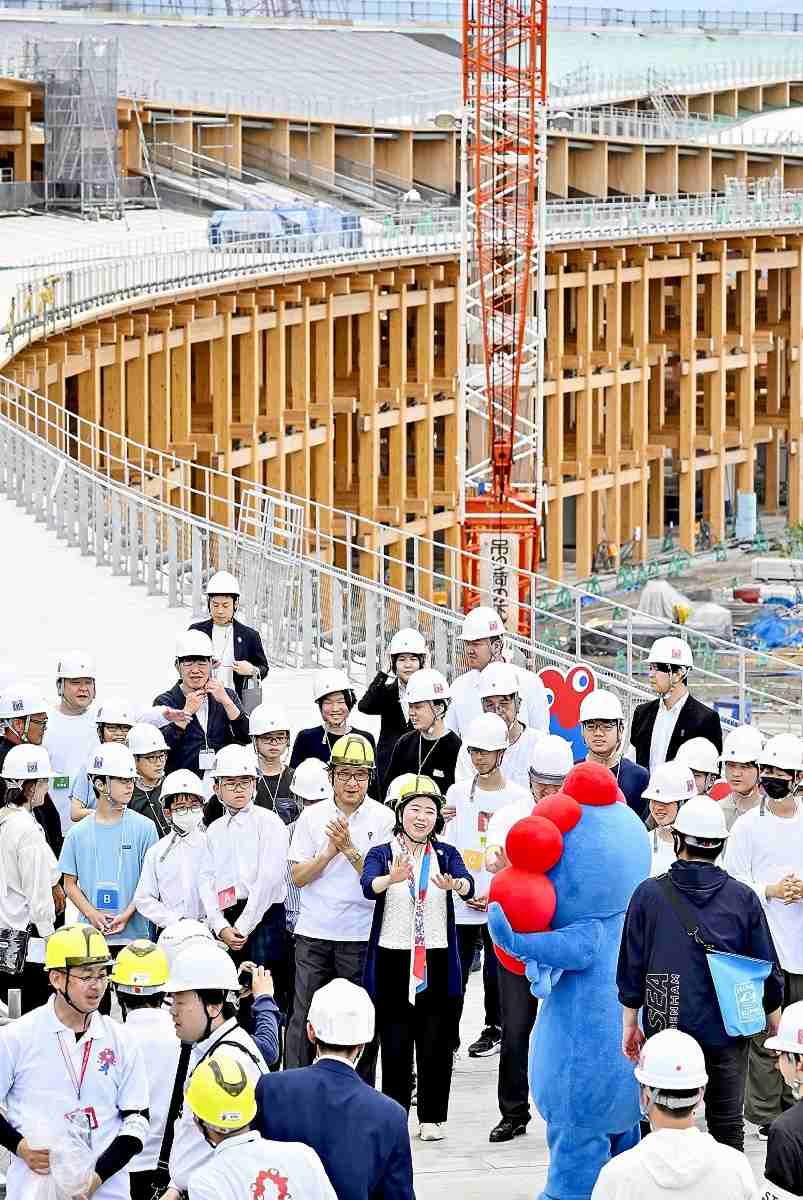Osaka Expo Failing to Generate Excitement Among Public; Cuisine, Pop Culture Elements Could Spark Interest

Members of the public get a sneak peek at the venue of the 2025 Osaka-Kansai Expo for the first time on June 30.
8:00 JST, July 6, 2024
The Kansai region, which includes Osaka, is enjoying an inbound tourism boom. According to the Osaka Convention and Tourism Bureau, 14 million foreigners are expected to visit Osaka this year, roughly 10% more than in 2019, before the coronavirus pandemic. Yet, there is concern over whether a large-scale international event to be held in Osaka will attract many people. The opening of that event, the 2025 Osaka-Kansai Expo, is less than a year away.
According to a Mitsubishi Research Institute survey, 27% of respondents expressed an interest in visiting the Expo as of April this year, almost unchanged from the previous survey conducted in October 2023 and four points lower than in October 2022. The number of pre-ordered tickets sold was approximately 2.8 million as of June 19, or only 20% of the target.
The Japan Association for the 2025 World Exposition, the event organizer, decided at its board of directors meeting on June 27 that paper tickets will be also sold at convenience stores nationwide from October.
Tickets, which went on sale last November, are currently available only in electronic form. The association may have concluded that this is the reason individual purchases have been sluggish. For example, many elderly people are not used to dealing with electronic tickets.
The reason for exclusively using electronic tickets is to manage the number of visitors and avoid congestion. While this might be a reasonable approach if efficiency were the priority, it is counterproductive if it deters the public from buying tickets at all. Perhaps both electronic and paper tickets should have been available for purchase from the beginning.
Even if the ticket sales process is improved, it is difficult to say for sure that the Expo will be able to attract visitors. Notably, there is little anticipation for the event. There seems to be a lack of excitement.
The appeal of the Expo must be enhanced.
Why aren’t people paying more attention to the Expo? Perhaps it is because there is no “centerpiece” that makes people want to visit the Expo so they can see it with their own eyes. Past Expos in Japan did have such attractions. The 1970 Osaka Expo featured a moon rock, and the 2005 Aichi Expo highlighted a mammoth specimen. Whether such a highlight is announced in advance will affect ticket sales.
Today, thanks to social media and online videos, we can experience a wide variety of things as if we were there. It may be difficult to come up with something that can only be seen by visiting the Expo site. However, the people involved in the Expo’s operation and the participating companies are focusing their efforts on various ideas. A “flying car,” which is expected to be the next generation of transportation, is interesting, but it is hard to position it as the centerpiece of the Expo.
Because of this situation, it seems inevitable at this point that attention tends to focus on what will happen with the overseas pavilions to be constructed by participating countries. For those countries that have not made progress in constructing their own pavilions, the Expo association has proposed moving to a simplified Type X pavilion, but it is highly likely that only three of the nine Type X pavilions under construction will be used.
It is quite understandable that the association wants to complete all planned pavilions in time for the opening of the Expo. On the other hand, it is questionable whether the “simplified pavilions” will be able to entertain visitors.
There is no doubt that various efforts are underway to make the Expo more exciting. Among them, I would like to focus on the movement to promote “Japan’s appeal” through the Expo.
Japanese food is one major thing inbound visitors seek. What if all types of Japanese food were available in one place? It seems that the Expo can take advantage of this idea to get support from across the nation. In June, the Osaka Chamber of Commerce and Industry announced plans for a social media project to promote original “Expo menus” created by restaurants and other businesses. The chamber is also considering having restaurants exhibit at the Expo and offer their own menus. If Japanese culinary experiences that are exclusive to the Expo attract inbound visitors, there will be a huge influx of people to the Expo.
Many local governments across Japan, including those of Shizuoka and Yamaguchi prefectures, have already decided to participate in the Expo to showcase their local ingredients and cuisine. A cornucopia of foods from all over Japan is sure to be attractive to visitors.
Japanese anime and manga have taken the world by storm. A full-size Gundam will be on display in a pavilion that will bring the world of the popular anime “Mobile Suit Gundam” to life. Anime and manga events attract large numbers of visitors. If exclusive events can be held during the Expo, we will be able to attract people from Japan and abroad.
We know that Japanese food and anime are not such new items and are available in other areas. However, they have the potential to make the Expo more attractive and bring in more visitors. The Expo must first become a place where people from all over the world can enjoy finding things of interest. There is still time.
Political Pulse appears every Saturday.

Norimasa Tahara
Norimasa Tahara is an editor in the editorial bureau of The Yomiuri Shimbun Osaka.
"Editorial & Columns" POPULAR ARTICLE
-

Violations of Subcontract Law: Major Automakers Must Eliminate Old Practices
-

Local Governments’ Tax Revenues: Devise Ways to Correct Imbalances in Tax Sources
-

5 Japanese Business Dinner Mistakes to Avoid — and What They Taught Me About Business in Japan
-

Heavy Rains in Asia: Support for Victims, Flood-Control Measures Urgently Needed
-

Rice Coupons: A Misguided Approach to Countering Rising Prices
JN ACCESS RANKING
-

Tokyo Economic Security Forum to Hold Inaugural Meeting Amid Tense Global Environment
-

Keidanren Chairman Yoshinobu Tsutsui Visits Kashiwazaki-Kariwa Nuclear Power Plant; Inspects New Emergency Safety System
-

Imports of Rare Earths from China Facing Delays, May Be Caused by Deterioration of Japan-China Relations
-

University of Tokyo Professor Discusses Japanese Economic Security in Interview Ahead of Forum
-

Japan Pulls out of Vietnam Nuclear Project, Complicating Hanoi’s Power Plans























